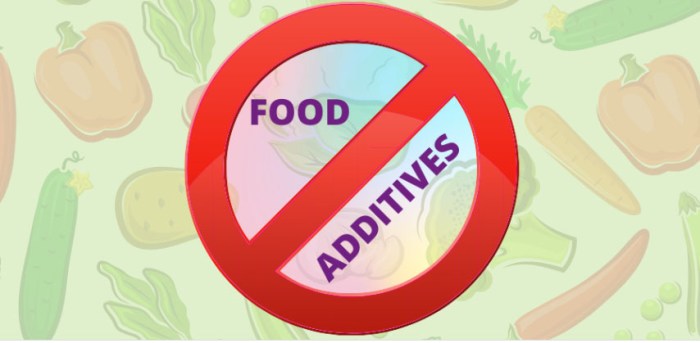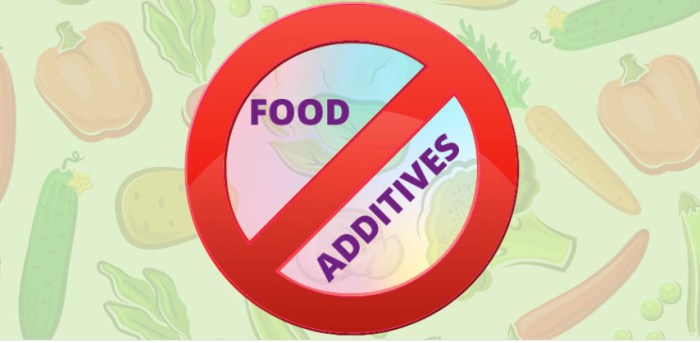
Food additives US FDA banned Europe: This exploration delves into the fascinating world of food additives, examining the contrasting regulatory landscapes of the US and Europe. We’ll uncover the specific additives prohibited in each region, understand the reasoning behind these decisions, and analyze the impact on both the food industry and consumer choices. From historical context to potential future trends, this comprehensive overview provides a detailed look at this crucial topic.
The US Food and Drug Administration (FDA) and the European Food Safety Authority (EFSA) have different approaches to approving and regulating food additives. This difference leads to varying lists of banned or restricted additives. This article will meticulously compare the processes, analyze the rationale behind the bans, and examine the consequences for manufacturers and consumers.
Introduction to Food Additives
Food additives are substances intentionally added to food to improve its appearance, texture, taste, preservation, or nutritional value. They play a crucial role in the food industry, enabling the production of safe, palatable, and shelf-stable food products. From preservatives that prevent spoilage to colorants that enhance visual appeal, additives are ubiquitous in the modern food supply. However, their use raises concerns about potential health impacts, which necessitates careful regulation and scrutiny.The food industry relies on additives to ensure food products remain safe, palatable, and readily available.
Additives contribute to the quality, consistency, and cost-effectiveness of the food supply chain. They facilitate the production of foods that are palatable and maintain their quality over extended periods. This allows for wider distribution and greater consumer choice, while minimizing waste and enhancing efficiency.
Regulatory Frameworks for Food Additives
The use of food additives is subject to rigorous regulatory frameworks in both the United States (US) and Europe. These frameworks aim to ensure the safety and suitability of these substances for human consumption. The specific procedures and criteria for approval vary between the two regions.
US Food Additive Approval Process
The US Food and Drug Administration (FDA) is responsible for evaluating the safety of food additives. The process typically involves a thorough assessment of scientific data, including toxicity studies, to determine the safety of a specific additive. The FDA considers factors like the additive’s chemical structure, potential health effects, and the levels at which it might be used.
Ever wondered why certain food additives are banned in the US but not in Europe? It’s a fascinating area, but the complexities often extend beyond the simple science of food safety. This reminds me of the concept of “state secrets privilege,” which, as explained in more detail here state secrets privilege explained , protects sensitive information in the public interest.
Ultimately, the different regulations on food additives in the US and Europe highlight the diverse approaches to public health and safety standards.
A critical component of the process is public comment periods to encourage input from interested parties.
European Food Additive Approval Process
The European Food Safety Authority (EFSA) evaluates the safety of food additives in Europe. The process is highly scientific and emphasizes risk assessment. EFSA considers factors such as the additive’s potential health effects, technological necessity, and the overall risk-benefit profile. The European Commission plays a key role in implementing the recommendations of the EFSA.
Comparison of Approval Processes
| Feature | US FDA | European EFSA |
|---|---|---|
| Regulatory Body | Food and Drug Administration (FDA) | European Food Safety Authority (EFSA) |
| Primary Focus | Safety and efficacy of additives | Risk assessment and technological necessity |
| Public Input | Public comment periods | Extensive public consultations and scientific peer review |
| Approval Criteria | Safety data and demonstrated need | Safety, efficacy, and technological necessity |
| Decision-Making | FDA makes the final decision | EFSA provides recommendations, EC makes the final decision |
The table above provides a concise comparison of the approval processes for food additives in the US and Europe. Differences exist in the specific roles of regulatory bodies and the emphasis on public input, ultimately reflecting different approaches to ensuring food safety and consumer protection.
Banned Additives in the US

The US Food and Drug Administration (FDA) plays a crucial role in ensuring the safety of the food supply. One of the FDA’s key responsibilities involves regulating food additives, substances intentionally added to food to enhance its appearance, taste, texture, or preservation. This oversight is essential to protect public health from potential harm. However, not all additives are considered safe, and some have been banned or restricted due to emerging evidence of health risks.This exploration delves into the specific food additives that the FDA has deemed unsafe for consumption in the US, examining the reasons for their prohibition and the historical context behind these decisions.
Understanding these cases is critical to appreciating the complexities of food safety regulation and the ongoing scientific process involved in evaluating potential health risks.
Banned and Restricted Additives in the US
The FDA’s stance on food additives is not static. Scientific advancements and evolving understanding of potential health consequences lead to changes in regulations. This dynamic process ensures that the nation’s food supply is as safe as possible.
| Additive | Potential Health Risks | Date of Ban/Restriction | Reason for Prohibition |
|---|---|---|---|
| Red Dye #2 (FD&C Red No. 2) | Suspected links to cancer and other health issues, particularly in susceptible individuals. Early studies raised concerns. | 1976 | The FDA determined that there was sufficient evidence linking the dye to potential carcinogenic effects, necessitating its removal from the market. |
| Cyclamates | Evidence suggested potential links to bladder cancer in animal studies. | 1970 | Following a thorough review of the available scientific data, the FDA concluded that the potential risk outweighed the benefits, leading to its ban. |
| DDT (Dichlorodiphenyltrichloroethane) | Concerns arose about its potential to cause harm to human health, particularly through bioaccumulation in the food chain. Significant research linked it to endocrine disruption and other health concerns. | 1972 | The scientific consensus, after rigorous testing and monitoring, pointed to DDT’s harmful effects on human health and the environment, warranting its removal from food production. |
| Certain Nitrates and Nitrites | High doses may be linked to potential health risks. The concern was centered on their ability to form nitrosamines, which are suspected carcinogens in certain contexts. | Variable (depending on use and concentration) | The FDA requires careful monitoring and controlled use to mitigate any potential risk. Regulations exist to limit the levels of nitrates and nitrites in processed meats and other food products. |
History and Scientific Evidence
The decision to ban or restrict an additive is not taken lightly. Extensive research, including animal studies, human observational studies, and epidemiological data, play a significant role in the FDA’s evaluations. This thorough assessment process aims to balance the potential benefits of an additive with the potential risks to public health.
Potential Health Risks
Understanding the potential health risks associated with each banned or restricted additive is essential. While the FDA’s evaluations aim to be comprehensive, the evolving nature of scientific understanding necessitates ongoing review and monitoring. The health risks range from potential cancer links to other adverse effects, highlighting the importance of responsible food regulation.
Banned Additives in Europe

Europe’s approach to food additives is significantly different from the US. While both regions aim to ensure food safety, the European Union (EU) employs a more stringent and precautionary principle-based system. This often leads to bans or restrictions on additives deemed potentially harmful, even if the evidence isn’t as conclusive as in some cases in the US. This proactive approach reflects a broader European societal concern for health and well-being, as well as a preference for consumer safety over potential economic gains.The EU’s approach to regulating food additives is not static.
Scientific advancements, emerging research, and public concerns frequently necessitate adjustments to the list of permitted substances. This dynamic process highlights the ongoing dialogue between scientific understanding, public health considerations, and the practical application of food safety regulations.
European Union’s Banned Additives
The European Union maintains a comprehensive list of prohibited or restricted food additives. These decisions are based on a rigorous assessment of potential health risks. These assessments often involve extensive research, expert opinions, and public consultations. This systematic approach prioritizes consumer safety over potential economic considerations.
| Additive | Reason for Prohibition | Date of Ban |
|---|---|---|
| Azorubine (E122) | Potential for allergic reactions and possible link to hyperactivity in children. | 2010 |
| Tartrazine (E102) | Potential for allergic reactions and hyperactivity in children. Concerns about its potential to cause or worsen certain medical conditions. | 2010 |
| Quinoline Yellow (E104) | Potential for allergic reactions, particularly in sensitive individuals. | 2010 |
| Sunset Yellow (E110) | Potential for allergic reactions and potential to cause or worsen certain medical conditions. | 2010 |
| Allura Red AC (E129) | Potential for allergic reactions and hyperactivity in children. Specific concerns about its impact on children’s behavior. | 2010 |
Historical Context and Scientific Basis
The EU’s decisions regarding food additives are rooted in a historical context of evolving scientific understanding and societal concerns. Initially, the approach was less rigorous. However, as scientific research expanded and public awareness grew, the EU recognized the need for a more cautious approach to ensure food safety. This cautious approach often leads to more extensive testing and more stringent requirements compared to the US.
Comparison of European and US Approaches
The US and EU differ significantly in their regulatory approaches to food additives. The US generally follows a “risk assessment” model, where potential hazards are evaluated based on scientific evidence. The EU, on the other hand, often employs a more precautionary approach, where the potential for harm, even if not definitively proven, is considered a valid reason for restricting or banning an additive.
This difference in philosophy has resulted in different lists of permitted and prohibited substances.
Comparing US and European Regulations
The US and European Union, while both aiming to ensure food safety, adopt different approaches to regulating food additives. These differences stem from varying historical contexts, scientific understanding, and public perceptions of risk. Understanding these contrasts is crucial for businesses operating in both markets and consumers making informed choices.
Similarities in Regulatory Approaches
Both the US and the EU prioritize food safety and consumer protection. They both have systems for evaluating the safety of food additives, although the specific criteria and processes differ. Both jurisdictions recognize the importance of transparency and public engagement in the approval and use of food additives. This shared commitment underscores the fundamental importance of food safety across different regulatory frameworks.
Differences in Regulatory Standards
The US employs a “generally recognized as safe” (GRAS) approach for many food additives, allowing for a more flexible and potentially faster approval process. Europe, on the other hand, utilizes a more stringent, risk-assessment-based system. This difference in philosophy is a key driver of the divergent regulations. The EU’s more comprehensive risk assessment is designed to minimize potential health hazards associated with food additives.
Reasons for Discrepancies
The contrasting regulatory approaches reflect different cultural values and priorities. The US emphasizes economic efficiency, while the EU often places greater emphasis on health protection. Different scientific understanding and public perception of risk further contribute to the variations. The historical evolution of food safety regulations and the varying political landscapes in each region have also played a role.
Impact on the Food Industry
The differing regulations impact businesses operating across both regions. Companies must navigate distinct approval processes and potentially adapt their product formulations. The EU’s more stringent standards can increase costs for manufacturers, potentially leading to variations in product pricing. This disparity can present challenges for companies seeking to market their products globally.
Impact on Consumers
Consumers in the US and Europe experience varying degrees of access to specific food additives. The US approach might lead to a wider range of products with potentially more additives. The EU’s more restrictive approach could result in a smaller range of products with fewer additives. Consumer awareness and choice is also affected by the availability of information regarding food additives in each region.
Comparison Table
| Regulatory Body | Approach to Banned Additives | Justification | Impact |
|---|---|---|---|
| US FDA | Generally recognized as safe (GRAS) process, with a potential for faster approval for certain additives. | Focuses on economic efficiency and allowing for a quicker introduction of safe additives to the market. | Can lead to a wider range of products, potentially with more additives, but might present potential challenges in monitoring and oversight. |
| EU EFSA | Risk assessment-based approval process with a stricter evaluation of the safety of each additive. | Prioritizes health protection and a comprehensive analysis of potential risks before approval. | Results in a more limited range of products, but with a greater assurance of health safety. Can increase costs for manufacturers and potentially influence product pricing. |
Impact on the Food Industry
The FDA’s and Europe’s regulatory decisions regarding food additives have profoundly reshaped the food industry. Manufacturers have had to adapt their processes and product formulations, leading to a complex interplay of cost considerations, consumer preferences, and the pursuit of innovative solutions. These changes have impacted everything from the ingredients used to the overall cost of food production.
Shift in Product Formulations
Manufacturers have had to adjust their formulations to comply with the bans and restrictions. This often involves intricate substitutions and redesigns to maintain the desired taste, texture, and appearance of their products. The development of new recipes and techniques is a significant aspect of this adaptation, and this process has led to both challenges and opportunities for innovation. Some products have seen minor adjustments, while others have undergone major reformulations, highlighting the significant impact of these regulatory changes.
Alternative Ingredients and Solutions, Food additives us fda banned europe
Food manufacturers have actively sought alternative ingredients to replace those banned or restricted. This has spurred significant research and development into natural and synthetic alternatives. The search for cost-effective and readily available substitutes has become a crucial part of the food industry’s response to these regulatory changes.
Table of Alternative Ingredients
| Banned/Restricted Additive | Alternative Ingredient(s) | Impact/Explanation |
|---|---|---|
| Sodium benzoate (preservative) | Natural preservatives like Vitamin C, or citric acid | These alternatives often offer similar preservative qualities, but may require different processing methods or application rates. |
| Tartrazine (yellow dye) | Vegetable colorings, such as turmeric or saffron | Vegetable colorings offer a natural alternative, but may require adjustments in terms of color intensity or shade matching. |
| BHA/BHT (antioxidants) | Tocopherols (vitamin E) or other natural antioxidants | Natural antioxidants are often used as replacements, though some may require different processing methods or application rates to achieve the desired outcome. |
| Bromated flour | Various flour blends and baking techniques | Manufacturers are exploring different flour types, mixing techniques, and other baking strategies to offset the effects of the absence of bromated flour. |
Impact on Consumer Choices
Consumers are increasingly aware of the ingredients in their food, and this has led to a rise in demand for products with natural ingredients. Companies have recognized this shift and are now emphasizing natural and organic options in their product lines. Transparency in ingredient lists has become more crucial for attracting consumers.
Ever wondered why some food additives are banned in Europe but not in the US? It’s a complex issue, and it’s not just about safety; it’s also about the varying standards and regulations across different regions. Interestingly, industry leaders are also discussing the importance of digital access for society, which is something we need to consider when examining global regulatory differences.
Ultimately, understanding these nuances in food additive regulations is crucial for making informed choices about the food we eat. industry leaders discuss the importance of digital access for society It highlights the need for transparency and consistent standards when it comes to food safety.
Impact on Consumer Choice
Food additive bans, particularly those differing between the US and Europe, significantly impact consumer choices. Consumers are increasingly aware of the ingredients in their food and are influenced by regulations. This awareness shapes their preferences and purchasing decisions, leading to shifts in the food industry’s offerings. Navigating the intricacies of labeling standards and understanding the rationale behind different regulations is crucial for informed consumer choices.
Consumer Awareness and Concerns
Consumer awareness of food additives has grown substantially in recent years. This heightened awareness is driven by a combination of factors, including increased media attention on potential health risks associated with certain additives, and a growing desire for more transparent and natural food options. Concerns regarding artificial colors, preservatives, and flavor enhancers have fueled consumer demand for products with fewer or no added ingredients.
This rising awareness significantly influences purchasing choices, pushing manufacturers to reformulate products or develop new ones that align with consumer preferences. The perceived health implications of additives are a primary concern, alongside environmental and ethical considerations.
The US FDA’s stance on food additives differs from Europe’s, banning some ingredients that are still used across the pond. Interestingly, this difference in regulations sparks an intriguing discussion about health standards, as highlighted in a recent interview with Rashid Johnson at the Guggenheim. The interview, available here: rashid johnson guggenheim interview , sheds light on broader societal implications of these choices.
Ultimately, the varying approaches to food additives raise questions about the global approach to consumer safety and food production.
Identifying Food Additives on Product Labels
Understanding food additives on product labels is crucial for informed consumer choices. The way additives are listed varies significantly between the US and Europe, impacting consumers’ ability to identify them. Consumers need to understand the labeling standards and the specific terminology used to describe additives in each region.
US Labeling Standards
US labeling standards are primarily based on the use of the specific name of the additive. For instance, a product containing sodium benzoate as a preservative would list it by its name. This straightforward approach allows consumers to easily identify the additive. However, the lack of a standardized format across different product categories can make comprehensive comparison challenging.
For instance, different manufacturers may use varying levels of detail or order in listing ingredients.
European Labeling Standards
European labeling standards, under the EU’s Food Additives Directive, often use E numbers to identify additives. Each additive has a unique E number, making identification relatively simple. This standardized approach facilitates comparisons across various products. However, some consumers might find the E number system less intuitive or user-friendly compared to simply listing the additive’s name.
Comparing US and European Labeling Differences
| Feature | US | Europe |
|---|---|---|
| Additive Identification | Additive name | E number |
| Standardization | Varying levels of detail | Standardized E number system |
| Consumer Understanding | Potentially easier to understand additive name | Potentially easier to compare different products |
The differences in labeling standards necessitate a deeper understanding from consumers. This requires careful reading of product labels and a willingness to research unfamiliar E numbers to fully grasp the ingredients in their food. This understanding directly influences the choices consumers make in the marketplace.
Future Trends and Developments: Food Additives Us Fda Banned Europe
The landscape of food additives is constantly evolving, driven by evolving consumer preferences, scientific advancements, and regulatory pressures. Future trends will likely involve a more nuanced approach to food safety, emphasizing transparency and consumer choice, alongside a growing emphasis on sustainability and ethical sourcing. This shift demands proactive adaptation from the food industry and a keen understanding of the evolving regulatory framework.The future of food additive regulations in both the US and Europe will likely be shaped by several key factors.
These include the increasing demand for natural and minimally processed foods, rising concerns about potential health risks associated with specific additives, and the growing emphasis on sustainability in food production. Moreover, the ongoing development of novel technologies and scientific understanding will continue to influence the types of additives permitted and their use.
Potential Future Trends in Food Additive Regulations
The future regulatory landscape for food additives is poised to undergo significant shifts. Regulations will likely become more stringent in addressing potential health risks, particularly in light of emerging scientific evidence. Additionally, a greater focus on transparency and consumer information is anticipated, allowing consumers to make informed choices about the foods they consume.
- Increased Scrutiny of Emerging Additives: As new technologies and ingredients emerge, the regulatory process will need to adapt to assess their potential impact on human health. This necessitates a more rapid and comprehensive evaluation process, potentially leading to a more cautious approach to the approval of novel additives.
- Emphasis on Sustainability and Natural Alternatives: The growing consumer demand for sustainable and natural food options will influence the development and use of food additives. Regulations might favor natural alternatives to synthetic additives, promoting the use of ingredients derived from plant-based sources and reducing reliance on petroleum-based chemicals.
- Transparency and Labeling Requirements: Consumers are increasingly demanding transparency in food labeling. Future regulations may require more detailed and explicit labeling of food additives, including their potential health effects, to empower consumers to make informed choices.
- Integration of Scientific Evidence: Ongoing research and scientific discoveries will continue to play a pivotal role in shaping regulatory decisions. As scientific evidence evolves, regulations may adapt to reflect this new knowledge, potentially leading to bans or restrictions on certain additives currently deemed safe.
Emerging Scientific Evidence and its Impact
The impact of emerging scientific evidence on future regulations cannot be overstated. Studies on the long-term effects of specific additives, or interactions between multiple additives, will likely influence the regulatory landscape. The accumulation of robust data on the safety of certain additives will be crucial in determining their continued use.
- Long-term Health Effects: Research into the long-term effects of specific food additives on human health, particularly concerning chronic diseases, will play a critical role in future regulatory decisions. Studies linking certain additives to adverse health outcomes may lead to restrictions or bans on their use.
- Interactions Between Additives: Research on the interactions between different food additives, and their cumulative effects on human health, will become increasingly important. Regulations will likely account for these complex interactions, leading to restrictions on combinations of additives, or potentially even bans on specific additive combinations.
- Allergenicity Studies: Further investigation into the allergenic potential of specific additives will influence regulatory decisions. Findings suggesting a higher risk of allergic reactions will likely lead to stricter labeling requirements or even bans on certain additives.
Potential Future Changes in Regulations
The potential future changes in both the US and European food additive regulations will likely reflect the trends described above. Regulatory agencies will adapt to new scientific evidence, consumer preferences, and technological advancements.
- Faster Approval Processes: Regulatory agencies might seek to streamline the approval process for novel food additives while maintaining stringent safety standards. This could be achieved through the use of new technologies and collaborative approaches.
- Greater Collaboration: International collaboration and knowledge sharing will become increasingly important for regulating food additives. Harmonizing standards and regulations across borders will lead to more consistent and effective safety measures.
- Emphasis on Risk Assessment: Regulatory agencies will likely focus more on assessing the potential risks associated with food additives, considering their impact on human health and the environment. This will involve incorporating more comprehensive risk assessment models.
Ending Remarks
In conclusion, the contrasting regulatory approaches to food additives in the US and Europe highlight the complex interplay between public health concerns, scientific evidence, and economic factors. The bans and restrictions have undeniably influenced the food industry, prompting shifts in product formulations and ingredient choices. Consumers, too, have been affected, experiencing a dynamic evolution in food labeling and awareness.
As scientific knowledge continues to advance, the future of food additive regulations promises further adjustments, impacting both the food industry and consumer behavior.


